Roman calendar, money, weights, and measures
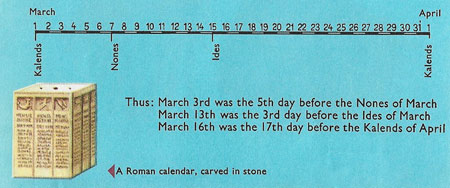
Figure 1. Roman calendar.
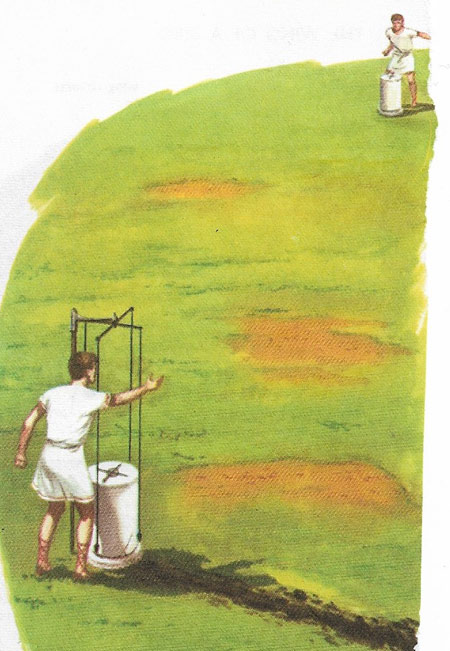
Figure 2. A Roman surveyor tracing the boundaries of a farm with an instrument called a groma.
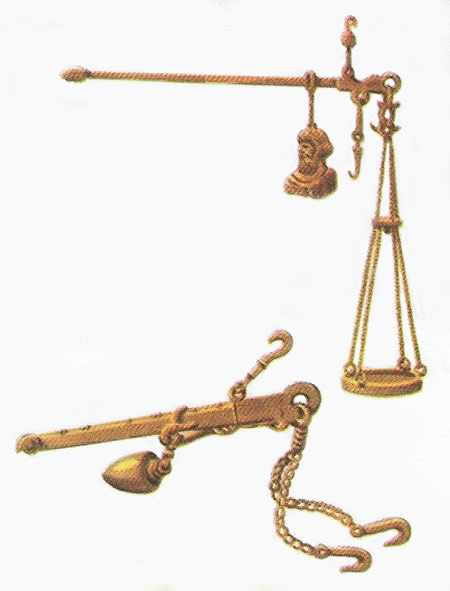
Figure 3. Two models of a Roman balance.
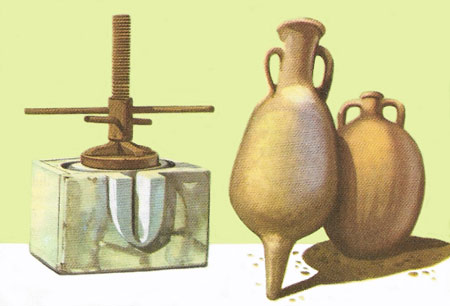
Figure 4. (Left) A Roman press for pressing olives. (Right). Characteristic Roman oil amphoras. The point at the bottom was thrust into the ground.
Roman calendar
In ancient Rome the years were usually called after the consuls. For instance, the Emperor Augustus was born 'M. Tullio Cicerone C. Antonio consulibus' (meaning 'when Marcus Tullius Cicero and Gaius Antonius were consuls') or, as we should say 63 BC. This seems to us a strange way of numbering the years; yet the Romans did not find it so: other ancient city-states used similar methods and, as consuls usually changed every year, the system was less clumsy in practise than it seems. It continued even under the emperors; though the emperors themselves tended to date documents and coins by the number of years they had been tribunes.
Roman historians occasionally use another system. Towards the end of the Roman Republic, learned Romans had calculated the date of the traditional founding of Rome as the year we call 753 BC. By this reckoning the Emperor Augustus was born in 691 AUC ('ab Urbe condita, or 'anno urbis conditae' – 'from the founding of the City').
Months
From a very early time the Roman year was divided into 12 months of varying lengths, with a total of 355 days. The remaining 10 days or so of the solar (sun) year were made up from time to time into an extra or 'intercalated' month called Mercedonius.
In the trouble times of the 1st century BC the system of intercalation broke down so badly that Julius Caesar had to make one year (46 BC) as long as 445 days. He decreed that henceforth the year should have 365 days, with one intercalated day every fourth, or leap, year. With one small change, this is the calendar we use today.
Using Caesar's reform, March was the first month of the year; this explains names such as 'September' and 'October'.
Ianuarius (January) – month of Janus, god of beginnings
Februarius (February) – month of purification (from februare, to purify)
Martius (March) – month of Mars
Aprilis (April) – month of sproutings (from aperire, to sprout)
Maius (May) – perhaps 'month of Maia'
Iunius (June) – month of Juno
Iulius (July) – in honor of Julius Caesar; this month was previously called Quintillus, meaning 'fifth month'
Augustus (August) – in honor of Augustus; before his time it was called Sextillis, meaning 'fifth month'
September – seventh month
October – eighth month
November – ninth month
December – tenth month
Days
'Beware the Ides of March!' said a soothsayer to Julius Caesar. His prophesy was fulfilled: Caesar was murdered on March 15th. But why 'the Ides"?
The Romans gave three days in each month special names: the Kalends, the Nones, and the Ides. The Kalends were the first of the month, and were so called from an old Latin verb kalare, to announce, because on the Kalends the priests the religious festivals due that month. The Ides ('days of light') were in theory the days of the full moon; they fell on the 13th of the month, except in March, May, July, and October, when they were the 15th. The Nones were always the ninth day (by Roman reckoning) before the Ides.
All other days of the month were reckoned backwards from these fixed points, counting both the first day and the last (Figure 1).
Roman coins
The earliest Romans, like other primitive agricultural peoples, used cattle (pecus) as their means of exchange in trade. When their first coins came into use, they called them pecunia because, in their eyes, each coin represented the equivalent value of a head of cattle. These coins were in fact simply bars of bronze weighing one unit (as); but, later, proper coins, circular in shape, with stamped figures were struck like our coins today. The first denominations were the as and its fractions.
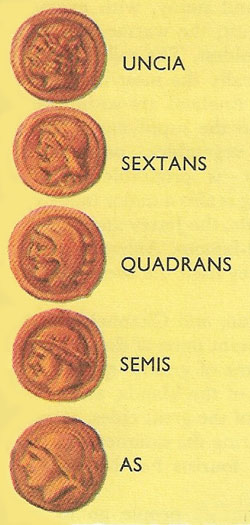 |
| Here are some Roman coins that were used in the 3rd century BC.
|
For coining, the Romans used a tool consisting of two little hammers, known as a coining die.
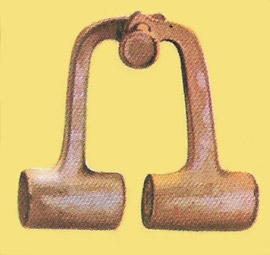 |
| A coining die – the instrument used by the Romans for coining money.
|
When the coinage of silver began, the basic unit was the sesterius, which became the best-known Roman coin.
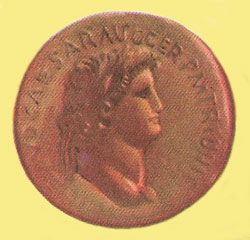 |
| A fine orichalcum (brass) sesterius of the Emperor Nero (AD 54–68).
|
The word 'sesterius' means 2½, and at first a sesterius was in fact worth 2½ asses. Later still the first gold coins were introduced. Here are three of these gold and silver coins:
SESTERIUS – silver unit
DENARIUS – silver 'penny' (4 sestertii)
AURIUS – gold piece (100 sestertii)
Weights
| as (or libra) | unit (or 'pound') | 0.72 lb |
| quadrans | 1/4 as | 2.88 oz |
| sextans | 1/6 as | 1.92 oz |
| uncia | 1/12 as ('ounce') | 0.96 oz |
| semuncia | 1/2 uncia | 0.48 oz |
| scrupulum | 1/24 uncia | 0.04 oz |
Some of these weights have the same names as Roman coins we have mentioned.This is because originally the coins were only pieces of metal of the stated weight: for instance, the coin called an as was of bronze and at first weighed one as (about 1½ ounces). As you can see, there were only 12 'ounces' in a Roman pound (Figure 3).
Measurements of length
Roman measurements of length, like ours, were based on parts of the body, but they were generally a little shorter than ours. The unit (pes, a foot) was usually divided, like the Roman pound, into 12 unciae (inches); but sometimes it was divided into 16 digiti (fingers). A gradus was a single step; a passus was two of our paces: left foot and then right.
| digitus (finger) | 1/16 pes | 0.73 in |
| uncia (inch) | 1/12 pes | 0.97 in |
| pes (foot) | unit | 11.65 in |
| cubitum (cubit) | 1½ pedes | 17.47 in |
| gradus (step) | 2½ pedes | 2.425 ft |
| stadium (furlong) | 125 passus | 202¼ yd |
| mille passus (mile) | 1000 passus | 1618 yd |
Measurements of area
As the earliest Romans were an agricultural people, it is not surprising that they had a system for measuring the size of their fields (Figure 2):
| pes quadratus | sq ft | 0.94 sq ft |
| actus quadratus | 1511 sq yd | |
| iugerum (land 2 oxen can plow in a day) | approx. 5/8 acre | |
| heredium (inherited field) | approx. 1¼ | |
| centuria | 100 heredia | approx. 125 acres |
Measurements of volume
These measurements are divided into two groups: those used for solids (such as grain and cereals) and those used for liquids (Figure 4).
| Dry measure | ||
|---|---|---|
| sextarius | unit | 0.96 pint |
| sesmodius | 8 sextarii | 7.68 pints |
| modius | 16 sextarii | 1.92 gallons |
| Liquid measure | ||
|---|---|---|
| cyathus | 1/12 sextarius | 0.08 pint |
| quartarius | 1/4 sextarius | 0.24 pint |
| sextarius | unit | 0.96 pint |
| congius | 6 sextarii | 5.76 pints |
| urna | 24 sextarii | 2.88 gallons |
| amphora | 48 sextarii | 5.76 gallons |
